Back from Paradise
Happy New Year! I hope the holidays were restful for you, and that you've entered 2014 with your battery recharged.
To make sure you've ushered in the new year properly, be sure to check out the latest essay:
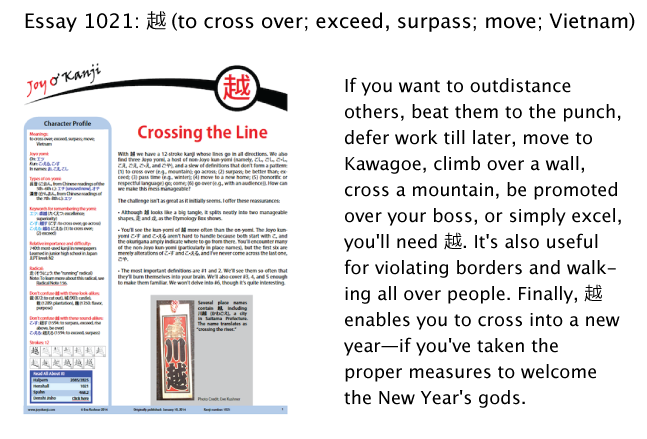
You may enjoy hearing New Year's greetings in a smattering of languages, including Japanese. This video is courtesy of Agro, who created it in collaboration with many women in Japan. He has launched a project to change the portrayal of women in the media, showing that there's more to a woman than her physical appearance. Go Agro!
I've had my own immersion in a multitude of languages, as I spent the holidays in Taiwan, then Thailand, then Taiwan again. Though the trip theoretically immersed me in Mandarin and Thai, I absorbed absolutely nothing of those languages, even when people tried to teach me Thai words. Instead, as usual, my eye went to all the kanji and hanzi (the Chinese word for Chinese characters) in both countries.

Photo Credit: Eve Kushner

Photo Credit: Eve Kushner
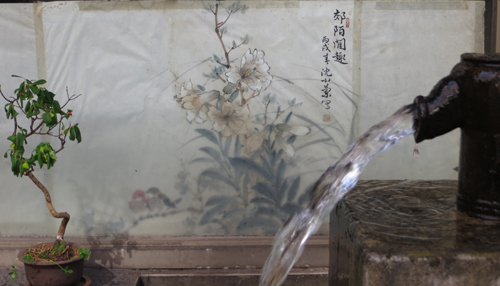
Photo Credit: Eve Kushner
My Own Private Japan
Actually, even the 13-hour plane ride from San Francisco to Taipei afforded me a full Japanese immersion. I saw a terrific movie about Keisuke Kinoshita, the man who directed 24 Eyes (my favorite!). I followed that with a so-so documentary called One Day in Japan, which shows one day in many people's lives, exactly one year after the disasters of March 11, 2011. Next I watched another documentary about learning to drive in three countries, including Japan. And I finally started Haruki Murakami's mammoth novel 1Q84 after owning it for a year. Seven flights later, I have only about 850 pages to go!
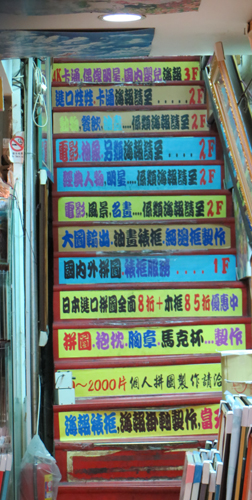
Photo Credit: Eve Kushner
Taipei staircase.
Chinese Charades
In Taipei, I soon realized that it was essential to know Chinese characters because people didn't speak nearly as much English as I had imagined they would. At a tea store on our first morning there, the owner and her son (?) spoke no English at all beyond "thanks" and "yes." Still we stayed because I was intent on buying puer. Taiwan is oolong country, and I had been lucky to spot a puer specialty store at all. From our trip to Hong Kong last year, I could readily recognize 普洱茶, "puer tea," in their sign. I choose to read it as "generally" (普) "wet ear" (洱), even though the non-Joyo 洱 actually represents a lake in Yunnan Province!
Anyway, we muddled through for awhile with hand gestures, but in truth we weren't getting very far. For some reason the woman assumed I could read hanzi fluently. Perhaps she had seen me scrutinizing label after label, but if she took that for comprehension, she was sorely mistaken. She kept bringing over cakes of puer, each with dense columns of characters on their labels. Grunting at me in Mandarin, she urged me to read what I could not possibly understand.
It seemed strange to me. In Japan they assume that Westerners could never master even the basics of their language. In Taiwan it was the opposite. I asked one cabbie if the red-and-white building on our right were the Presidential Palace (a site someone had recommended that we see). "Can you ask me in Chinese?" he said. No! Clearly not, or I would have! Then he said, "Obama," which I thought was a very clever workaround. Yes, it turned out to be the Presidential Palace!
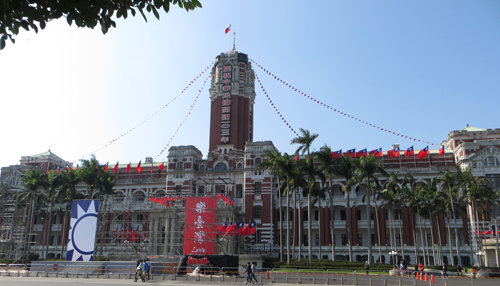
Photo Credit: Eve Kushner
Presidential Palace.
Back to the tea store, we sat there sipping puer that did nothing for me, and I fretted and fretted about how to convey that. Finally I remembered that my iPhone had Jack Halpern's Kanji Learner's Dictionary app, which Halpern had generously shared with me a year earlier. I had never needed to use it before, and I worried about producing any results under pressure, but I needn't have been concerned. What an elegant, handy tool it is! I'm by no means adept at manipulating small machines, but I didn't struggle with that app at all.
I typed in yowai, which brought up 弱, and I showed it to the tea store guy. He seemed relieved for the breakthrough and immediately set about making another batch of tea, this time from a cake aged about 10 years (or 10年, as they wrote for me).
Batch 2 was much better, so I typed in tsuyoi and koi, producing 強 (strong) and 濃 (rich, deep-colored). That hit the mark, and the guy and I beamed in satisfaction, though probably for different reasons. Later, when he brewed yet another batch, it was red, and I affirmed this by showing him 赤. It was silly, I suppose; he already knew what color it was. But I would have told him the sky was blue if it made our language barrier seem any smaller. (Actually, the sky was gray and rainy that day, but no matter.)
I was most amazed when I set my sights on a tea knife that he used to pry apart the densely packed layers of puer cake. I've needed such a thing for a long time and didn't know that it existed. Even though I've become a terrible ワープロ馬鹿 (ワープロばか: someone whose kanji-writing ability has suffered due to overreliance on typing Japanese on computers), I was able to write 刀 (knife) from memory (impressive, yes?!), and I copied 使 (to use) onto the page from the app. Voila—he presented me with a new tea knife on the spot and didn't even charge me!
Not everything translated well. Showing him and his mother 値段 (ねだん: price) made their brows furrow. For quite a long time, I had no idea how much the puer cakes would cost us. The mother wrote number after number followed by units in hanzi, and I never had the slightest idea what she was trying to communicate. After I thought of writing "?g," we were able to start talking about price per gram. Price tags would have helped immensely in that shop, but maybe every purchase has to involve bargaining.
I'm still astounded that we managed to leave with two puer cakes at a discounted price, along with the knife. About a half hour had passed, and I was buzzed on about four cups of increasingly strong puer, as well as the high of having communicated against all odds.
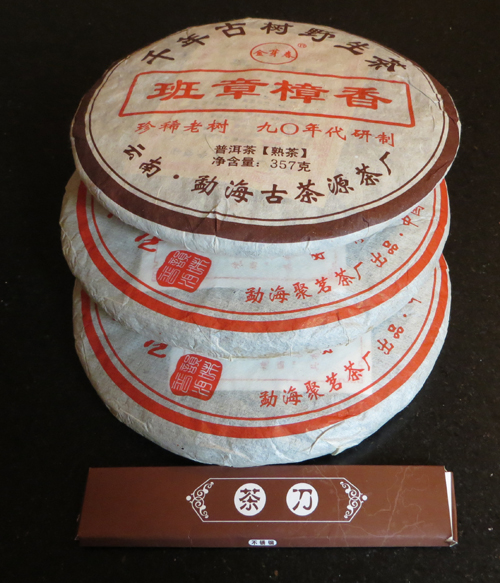
Photo Credit: Eve Kushner
By the time we left Taipei, we had scored three puer cakes, which are hard discs of compressed tea.
Hanzi Immersion
Japanese friends have told me that they adore Taiwan. One called it a kanji wonderland, and another dubbed it a Petit Japan. I can't entirely imagine how it is for them to be there, but for me it was a thrill to see sign after sign that I shouldn't have been able to read, by all rights, and often could.
Because I had just written Radical Note 156 on 走, the "running" radical, which included a photo of a sign in hanzi, I could recognize the two characters for "please do not," and I saw them everywhere.
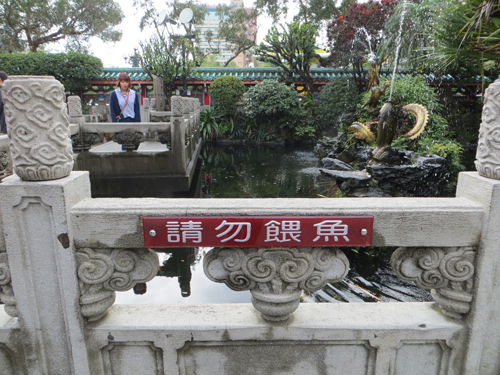
Photo Credit: Eve Kushner
Carp pond at Lungshan Temple (龍山寺) in Taipei. Please don't feed the fish!
I picked up more hanzi every day. Just a little knowledge is a wonderful entry point—or is it a dangerous thing? I don't think I was in any real peril, but I did float along with the misconception that Bangkok is in a valley (谷), when it's actually as flat as can be. I had the wrong idea because I kept seeing 曼谷 on electronic displays in the Taipei airport, right before the characters changed to "Bangkok." I recognized 曼 as the phonetic in 慢 (1837: arrogant; proud; boastful; sluggish; lazy), but I didn't know that the non-Joyo 曼 means "beautiful, wide." Had I known that, I would have been even more convinced about what Bangkok would look like. As it turns out, 曼谷 is just a phonetic match, as many Chinese place names are. Oh, well. It's just one more reminder that kanji doesn't correspond to absolutely everything in the world, even though it's at the center of my life!
I have plenty of kanji/hanzi photos from the trip to share with you here, and I'll do so in coming weeks. Have a great weekend!

Comments